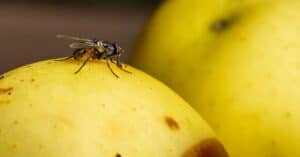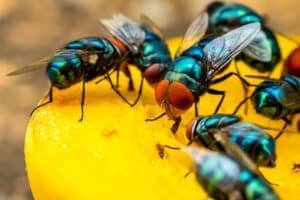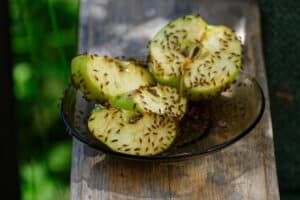According to insect expert Erica McAlister, there are 17 million flies for each person in the world. However, this is just an estimate, as there is no way anyone could ever determine an accurate number. Not many people know what purpose these pests serve, but they actually pollinate plants, eat the sludge in drainpipes, and consume decomposing carcasses. But, they also spread diseases, damage crops, and kill other insects more vulnerable than them, like dragonflies.
There are over 120,000 species of flies, with 18,000 inhabiting areas throughout North America. While these flies have short lifespans, they reproduce large numbers quickly. As a result, they can spread several diseases, like salmonella, malaria, and tuberculosis.
Flies: Where Do They Come From?
These pests typically hatch outside and find their way into homes through cracks or crevices, structural weak spots like a torn door or window screen, and damaged weather stripping. Flies lay their eggs in compost heaps, garbage cans, and rotting organic material. Furthermore, they can lay between 75 to 150 eggs at once, compressed together into a size of a pea. Therefore, they often go unnoticed.
Houseflies don’t get around much; they tend to stay within 20 miles of where they hatched. Fruit flies around the world are generally found in homes with food waste like rotten produce or overripe fruit. However, unlike many of their cousins, they make their way into homes by hiding on produce or other food. Horse flies tend to stay outside as there is nothing inside to feed on. However, there are times when they accidentally fly through open doors or windows and get stuck inside.
Types of Flies In the World
While there are thousands of species of flies, there are three common types of flies in the world that have been plaguing humans for centuries.
Horse Fly

Horse flies have large eyes — typically purple or green — with horizontal stripes.
©Vinicius R. Souza/Shutterstock.com
The horse fly doesn’t typically bother humans. It prefers the blood of horses and other mammals. Horse flies inhabit both suburban and rural areas which are close to bodies of water where they breed and that attract an abundance of mammal hosts.
Appearance
These flies are gray or black, and their bodies measure 0.39 to 1.82 inches long. Most horse flies have light-colored wings, but some subspecies have dark wings. Furthermore, their large eyes are typically purple or green, with horizontal stripes. Additionally, they have stout bodies without bristles, six legs, and short antennae.
Habits
Adult horse flies can fly more than 30 miles in one go because they are strong, fast fliers. However, they typically do not travel far. Instead, these flies rest on roads and paths, especially in wooded areas, where they sit and wait for a potential host. In fact, they are primarily attracted to dark objects that move. But, they are also attracted to light and often congregate at windows. You will mainly see them on hot, windless, and sunny days. Male horse flies feed on pollen, but females are aggressive feeders and use their mouthparts to tear into a host and lap up its blood, unlike mosquitoes that suck. Therefore, a bite from a horse fly is quite painful.
Threats
Luckily, horse flies are not known to be carriers of disease or capable of spreading disease-causing bacteria. However, their painful bite can cause swelling or an allergic reaction. Furthermore, they are stubborn pests and will continue to bite their hosts until they get their fill of blood or are killed. As a result, they can chase their target for short periods of time, making them incredibly annoying.
Fruit Fly

Fruit flies reproduce at an alarming rate, making them difficult to control.
©Anne Webber/Shutterstock.com
Anywhere in the United States, you can find fruit flies. They reproduce at a rapid rate, so there is an abundance of them wherever you go. Furthermore, they can survive indoors all year round but only have a lifespan of 25 days to a month.
Appearance
Mature fruit flies generally measure between 0.12 to 0.5 inches long and are tan or brown in color. In addition, they usually have red eyes. However, some species have darker eyes. Their thorax is tan, and they have gray abdomens. Lastly, they are tiny and oval, with six legs and antennae.
Habits
Things that attract fruit flies include rotting food matter and fermenting liquids, like:
- Beer
- Fruits and vegetables
- Liquor
- Wine
Furthermore, they like to breed in moist, dark, and unsanitary environments, like trash cans, drains, and garbage disposals. They can also reproduce at an alarming rate, making them difficult to control. For example, females can lay about 500 eggs at a time that hatch 24 hours later. Their lifecycle has four stages, similar to other fly species, that reach completion in seven days in ideal conditions.
Threats
While these flies are a major nuisance that is not their most significant threat to humans, they also contaminate food with harmful disease-causing pathogens and bacteria.
Housefly

While houseflies can’t bite, they can transfer more than 100 various pathogens, including typhoid, salmonellosis, and tuberculosis.
©AvishekS/Shutterstock.com
Houseflies are the most common flies in the world and plague homes around the United States. You probably know this fly well and might even be swatting one away right now.
Appearance
These flies are generally gray, with four black stripes on their thorax. Additionally, adults are between 1/8 to ¼ inch long. Furthermore, they have compound red eyes with thousands of lenses, giving them excellent vision, hair bodies, and a pair of wings. However, they don’t have any teeth or stingers.
If you ever see something resembling rice grains, there’s a good chance it is houseflies eggs. Maggots will emerge from these eggs that measure ¼ to 3/8 inches long. They have a greasy appearance and have cream coloring.
Habits
Their lifespan depends on their location. For example, it generally takes around six days for these flies to develop from egg to adult. However, it can take longer. Their lifecycle has four phases:
- Females lay their eggs on rotting meat, feces, garbage, or food and can produce between 350 to 900 eggs during their lifetime.
- Larvae hatch and feed at the egg-laying site for three to five days.
- Maggots find their way to cool, dark, and dry environments, where they develop into pupae over three to six days. This is the stage where they grow legs and wings and become adults.
- They pupate for two to three days until females are ready to reproduce, and the cycle starts all over again. Therefore, houseflies have an average lifespan of 15 to 25 days.
Luckily, these flies can’t bite because they have no teeth, so they only feed on liquids. However, their spongy mouth parts can liquefy many solid foods through saliva and regurgitation. Therefore their diets consist of the following:
- Human food
- Garbage
- Carcasses
- Pet waste
Threats
While these flies can’t bite, they can transfer more than 100 various pathogens, including typhoid, salmonellosis, and tuberculosis. Furthermore, the house fly can contaminate food surfaces by spreading organisms picked up on their mouths and legs when feeding on garbage, feces, and other decomposing substances. Lastly, they also defecate everywhere, which also spreads harmful bacteria.
Fly Prevention
The best way to prevent these pests from invading your home is through sanitation. Keep your home extremely clean by removing the garbage every day, cleaning the counters after use, checking window screens to ensure no tears or holes, and disposing of decaying food matter immediately. Additionally, if you have pets, you must pick up and dispose of their waste as soon as possible.
If you have a fly infestation, the best thing to do is call a professional. They will inspect the premises and hunt for egg-laying sites. Once the problem is eliminated, the professional can work out a fly treatment plan for your home to ensure it doesn’t happen again.
The photo featured at the top of this post is © AvishekS/Shutterstock.com
Thank you for reading! Have some feedback for us? Contact the AZ Animals editorial team.






